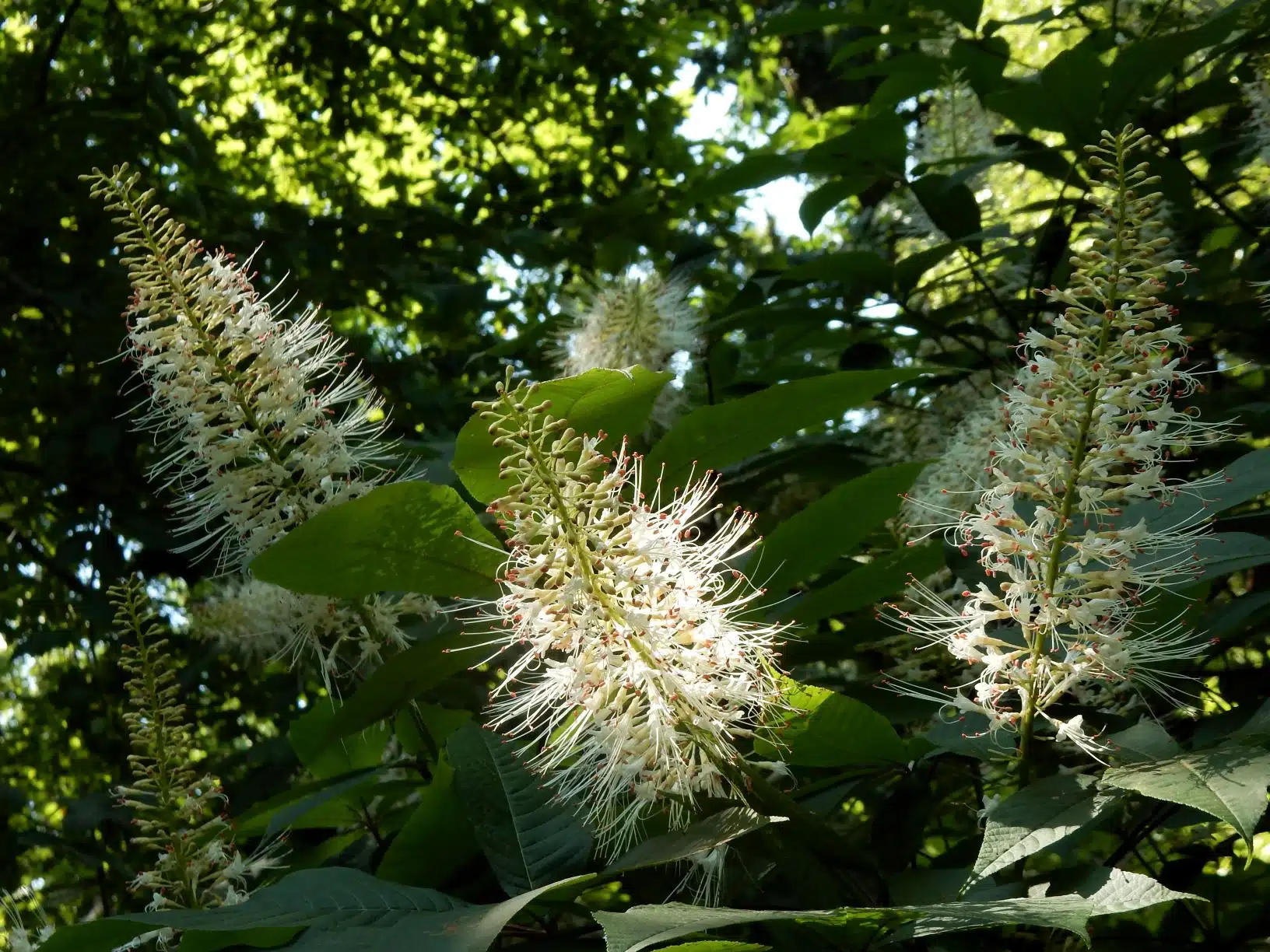Trees
Bottlebrush Buckeye
Aesculus parviflora

Aesculus parviflora, bottlebrush buckeye is my favorite shrub. It is a native of the southeastern United States, primarily to Alabama. The genus Aesculus and the maples, Acer, recently have been lumped into the soapberry family, Sapindaceae. At The Holden Arboretum our plants may be seen along the entry drive near the overflow parking area, in the Arthur S. Holden Sr. Hedge Collection, in the Arlene and Arthur S. Holden Butterfly Garden, west of Blueberry Pond among the conifers on Squirrel Ridge and at Lantern Court in the lawn on the southeast part of the property.
Although bottlebrush buckeye has received numerous commendations – including the Award of Garden Merit from the Royal Horticultural Society, being highly recommended by the Ohio Landscape and Nursery Association Plant Selection Committee, receiving the Theodore Klein Plant Award (Kentucky) and the Gold Medal from the Pennsylvania Horticultural Society – it remains an uncommon landscape plant.
One of the reasons I like this plant so much is its foliage. Being a native Buckeye myself, I am quite partial to its large compound leaves. Bottlebrush buckeye breaks bud very early in spring with the foliage commonly unfolding in mid-April and as early as April 2 in Holden’s gardens. The new leaves are bronzed with anthocyanins, which act as a sort of anti-freeze. The foliage remains relatively unblemished throughout the growing season and, in the latter part of October, the leaves briefly turn yellow before falling.
Flowering usually begins in the first week of July but has started as early as June 16 at Holden. The flowers typically last for about three weeks. There are many pollinators that frequent the flowers, including butterflies and hummingbirds. In the Holden Butterfly Garden and at Lantern court are planted a cultivar by the name of ‘Rogers,’ which commonly starts flowering as our other bottlebrush buckeyes are at the end of their bloom in the fourth week of July. While the inflorescences of ‘Rogers’ are longer than those of our other plants, they tend to be less erect and are floppy. Jenny Watson, who tended the Holden Butterfly Garden, reported that these plants are a favorite of the ruby-throated hummingbirds, which can get quite territorial and engage in aerial skirmishes with one another over the nectar of the flowers.
Seed set has been far from abundant on our plants with the small leathery brown capsules starting to ripen in late September. Although the fruit (and all parts of the plant) are poisonous to us and to livestock, squirrels snatch them up shortly after they hit the ground. Bottlebrush buckeye has been remarkably deer resistant at Holden with only one note in my records of “minor deer browse and moderate rodent damage to main stems – 25 March 2004” near Blueberry Pond.
In the 1980s bottlebrush buckeye was hard to find in the nursery trade. One morning as I arrived to work at the Arnold Arboretum I noticed that someone had illicitly dug out part of one of the old plants the night before. Fortunately, availability has increased in recent decades. In 1991 I purchased three plants at The Holden Arboretum Plant Sale. They were single sticks in one-gallon pots, very unimpressive and undoubtedly a reason why it is so difficult to retail this species. All three have done very well on a little rise of clay soil in part shade next to Virginia sweetspire, Itea virginica, and Japanese kerria, Kerria japonica whose dense stems serve as a much more effective screen in winter than the open-branched bottlebrush buckeye.
It is best to give this shrub plenty of space. Once established it typically spreads at a rate of a foot a year and does not stop. In youth, its height averages an increase of about 6 inches a year. Pruning is easy as the wood is soft and the branches few. It makes a fine specimen, becoming more graceful with age. This shrub is an excellent choice for planting along a woodland edge. Weeds seldom grow in the dense shade cast by a bottlebrush buckeye.
Last year a prominent Garden Club of America member was collecting seed at Holden for a propagation project and bottlebrush buckeye was one of her choices. Nurseries also root this plant from cuttings taken from suckers when a particularly desirable clone such as ‘Rogers’ is propagated. To date, no known hybrids of bottlebrush buckeye have been confirmed at Holden although a number of attempts have been made involving Aesculus californica (California buckeye), its closest relative.
Light: Full Sun
Site Selection: Open Spaces (Parks/ Lawns)
Size: Large
Tolerances: Clay Soils, Wet/ Saturated Soils




